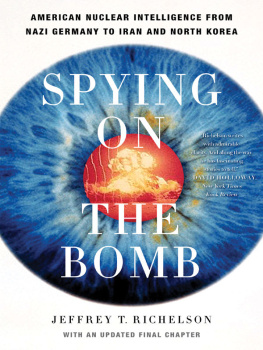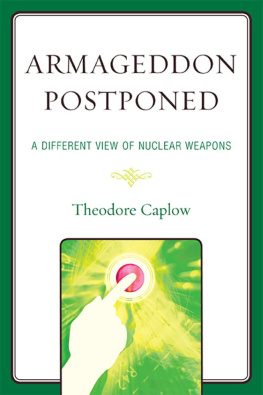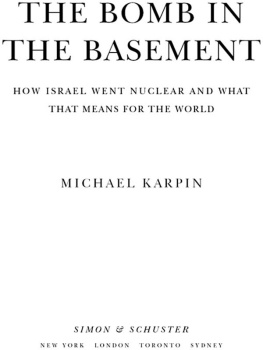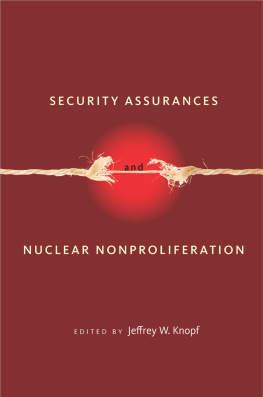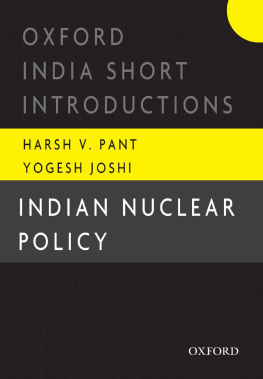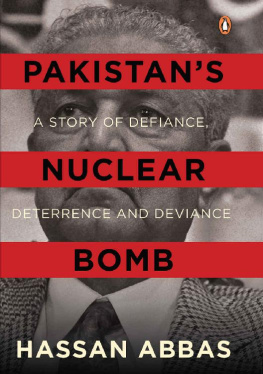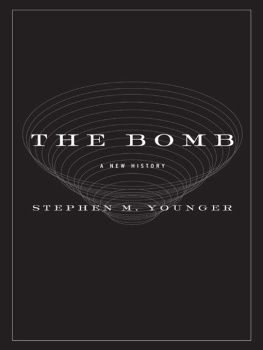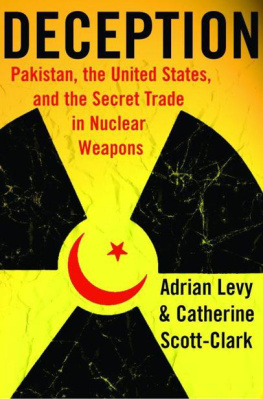

In memory of EDNA RICHELSON
FOR AS LONG AS WAR IS A THREAT, the spy is a ticking seismograph on top of the Jungfrau measuring distant atomic explosions on the other side of the world, or instruments carried in an aircraft that measure uranium or plutonium contents of the atmosphere.
IAN FLEMING
CONTENTS
Nazi Germany
The Soviet Union 19451953
The Soviet Union 19541961
The Peoples Republic of China through 1968
France and India through 1974
Israel, South Africa, and Taiwan through the 1970s
The Vela Incident: September 1979
Iraq, North Korea, Libya, and Pakistan through 1991
Israel, South Africa, and Taiwan in the 1980s and early 1990s
French and Chinese testing; suspected Russian testing in the 1990s
Indian and Pakistani tests in May 1998
Iraq from the end of the Gulf War through December 1998
Iraq, 19992004
Iran and North Korea, from the 1990s to 2005
Iran and North Korea, 20062007
FOLLOWING THE DISCOVERY of nuclear fission in 1939, several nations began programs to develop the ultimate weapon. Scientists in the United States, including many who had studied in Germany or had recently escaped from the German campaign of conquest, were concerned that the eminent scientists who remained, including Werner Heisenberg, might be able to produce a nuclear weapon for Adolf Hitlers use. The United States tried to find out whether those fears had a sound basis. In addition to relying on traditional intelligence methods, the Americans explored ways in which the signatures of nuclear activity could be detected.
In 1944, scientists deployed with the invading Allied armies discovered that the Germans had made little progress toward an atomic bomb. But the relief felt from that discovery would be replaced in a few years by fear of what the Soviet Union might accomplish in the nuclear field. Americas work on monitoring German progress toward the ultimate weapon provided a foundation for the far more extensive and long-lasting intelligence effort to uncover Soviet nuclear secrets.
The Soviet Union was not the only nation whose nuclear activities were of concern to the United States in the next decades. Other hostile nations seeking to become nuclear powersmost prominently the Peoples Republic of China, particularly given the loose talk about nuclear war that came from Chinese leadersalso worried American presidents. At least one president seriously considered a preemptive strike to prevent China from developing the bomb.
That friendly nations might try to join the nuclear club was another mounting concern. In the 1960s and 1970s, U.S. presidents tried their best to discourage Israel, Taiwan, South Africa, and India from building a nuclear arsenalfearful that every time a new nation joined the nuclear club, more nonnuclear nations would see it as a means to improve their status in the world. The United States feared that nuclear acquisition would prompt regional arms races and ultimately increase the risk of nuclear war, especially in the Middle East and on the South Asian continent. More recently, the nations seeking to join the nuclear clubSaddams Iraq, Islamic Iran, and North Koreawould be at the very top of any list of nations that the United States would want to deny membership in the nuclear club.
For over five decades the United States has devoted considerable resources to monitoring the quests by friends and foes to acquire nuclear weapons and improve their nuclear capabilities. The efforts to collect and analyze intelligence on foreign nuclear weapons programs have continued to involve both traditional methods such as human intelligence, aerial reconnaissance, and communications intelligence, and newer ones such as the detection of the signatures of nuclear detonations and of the production of fissile material.
The collected data has had many uses: keeping policymakers informed of foreign nuclear activities, determining and estimating the nuclear warfare capabilities of other nations, planning military operations to disrupt nuclear activities, supporting diplomatic initiatives to forestall nuclear weapons development, assisting inspectors from the International Atomic Energy Agency, and monitoring compliance with a number of arms control treaties. The latter include the 1963 Treaty Banning Nuclear Weapons Tests in the Atmosphere, in Outer Space, and Under Water; the 1968 Treaty on the Non-Proliferation of Nuclear Weapons; the 1974 Treaty on the Limitation of Underground Nuclear Weapon Tests (limiting tests to yields of no more than 150 kilotons); and the Comprehensive Nuclear Test Ban Treaty that prohibits all nuclear testing.
Spying on the Bomb traces the evolution of the U.S. nuclear intelligence effort, its successes and failures, from its origins in the early days of World War II to the first years of the twenty-first century. There is no simple explanation for success or failure in these endeavors. Given the different periods, different individuals, varying targets, and different technologies available for collecting intelligence, that should not be surprising.
The books focus is largely on the early nuclear programs of about fifteen nations, and the U.S. effort to determine if they were trying to acquire nuclear weapons, how far they had gotten, and their attempts to improve those capabilities. Thus, the core of the book examines the work of the CIA and other intelligence agencies in identifying and providing the details about those nuclear programs, as well as the agencies efforts to monitor and evaluate nuclear testingrather than their efforts to gather information on nuclear arsenals or during nuclear crises.
Each chapter focuses on the nuclear activities of one or a small number of nations during different periods starting in the 1940s and progressing to the new century. In addition, the chapters intermingle accounts of what was actually happening in foreign nuclear weapons programs, based on memoirs and other non-U.S. intelligencederived material, with the U.S. intelligence communitys understanding of what was taking place.
As a result, Spying on the Bomb focuses on the institutions, technologies, and people that have been part of the U.S. intelligence communityincluding Robert Furman, Moe Berg, Henry Lowenhaupt, the CIA, the Air Force Technical Applications Center, Joe T., and bhangmetersas well as on the institutions, technologies, and people that have been part of foreign nuclear weapons effortsincluding Andrei Sakharov, Jaffar Dhia Jaffar, Homi Bhabha, the Soviet Layer Cake bomb, the Lanzhou Gaseous Diffusion Plant, and the Pokhran test site.
JEFFREY T. RICHELSON
ALAMOGORDO, NEW MEXICO, was established in 1898, with the expectation that it would be one of many communities supporting the western expansion of the railroad. For the next thirty-five years, the city and railroad grew in tandem. But by December 1941, when the United States entered World War II, Alamogordo was a small town of 4,000 people existing on its economic past and a small tourist industry. One element of the wartime expansion of the U.S. armed forces was the establishment of the Alamogordo Bombing and Gunnery Range, subsequently renamed the Alamogordo Army Air Field.1
In May 1944, Dr. Kenneth T. Bainbridge, a Harvard University experimental physicist employed at another, far more secret, military installation in New Mexico, led an expedition through parts of the state. He was looking for a remote place where he and his colleagues at Los Alamos could determine whether their efforts to transform the theories of nuclear physics into a dramatic new weaponan atomic bombhad been successful. The Manhattan Projects scientific director, J. Robert Oppenheimer, had come along for the ride. The two physicists were searching for a piece of territory measuring approximately 17 by 24 miles that was just far enough from Los Alamos to make the town safe from the effects of a bomb test.2
Next page
